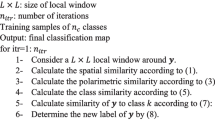Abstract
Aiming to solve the misclassification problems of unsupervised polarimetric Wishart classification algorithm based on Freeman decomposition, an unsupervised Polarimetric Synthetic Aperture Radar (SAR) Interferomery (PolInSAR) classification algorithm based on optimal coherence set parameters is studied and proposed. This algorithm uses the result of Freeman decomposition to divide the image into three basic categories including surface scattering, volume scattering, and double-bounce. Then, the PolInSAR optimal coherence set parameters are used to finely divide each of the three basic categories into 9 categories, and the whole image is divided into 27 categories. Because both the Freeman decomposition result and optimal coherence set parameters indicate specific scattering characteristics, the whole image is merged into 16 categories based on physical meaning. At last, the Wishart cluster is employed to obtain the final classification result. To preserve the purity of scattering characteristics, pixels with similar scattering characteristics are restricted to be classified with other pixels. The final classification results effectively resolve the misclassification problem, not only the buildings can be effectively distinguished from vegetation in urban areas, but also the road is well distinguished from grass. In this paper, the E-SAR PolInSAR data of German Aerospace Center (DLR), are used to verify the effectiveness of the algorithm.
Similar content being viewed by others
References
J. S. Lee, M. R. Grunes, T. L. Ainsworth, L. Du, D. L. Schuler, and S. R. Cloude. Unsupervized classification of polarimetric SAR images by applying target decomposition and complex Wishart distribution. IEEE Transactions on Geoscience and Remote Sensing, 37(1999)5, 2249–2258.
A. Freeman and S. A. Durden. Three-component scattering model to describe polarimetric SAR data. Proceeding SPIE Conference on Radar Polarimetry, San Diego, CA, USA, July 1992, 213–224.
J. S. Lee, M. R. Grunes, and L. Ferro-Famil. Unsupervised terrain classification preserving polarimetric scattering characteristics. IEEE Transactions on Geoscience and Remote Sensing, 42(2004)2, 722–731.
Wu Yi-rong, Hong Wen, and Wang Yan-ping. The current status and implications of polarimetric SAR interferometry. Journal of Electronics & Information Technology, 29(2007)5, 1258–1262) (in Chinese. 吴一戎, 洪文, 王彦平. 极化干涉SAR的研究现状与启示. 电子与信息学报, 29(2007)5, 1258–1262.
K. P. Papathanassiou and S. Cloude. Single-baseline polarimetric SAR interferometry. IEEE Transactions on Geoscience and Remote Sensing, 39(2001)6, 2352–2363.
L. Ferro-Famil, F. Kugler, E. Pottier, and J. Lee. Forest mapping and classification at L-band using Pol-InSAR optimal coherence set statistics. European Conference on Synthetic Aperture Radar, Germany, May 2006.
J. S. Lee, M. R. Grunes, T. Ainsworth, I. Hajnsek, T. Mette, and K. P. Papathanassiou. Forest classification based on L-band polarimetric and interferometric SAR data. Proceedings of the 2nd International Workshop PoLInSAR 2005, Frascati, Italy, January 2005, 17–21.
L. Ferro-Famil, E. Pottier, and J. Lee. Classification and interpretation of polarimetric interferometric SAR data. Geoscience and Remote Sensing Symposium, IGARSS’02, Toronto, Canada, 2002, 635–637.
L. Ferro-Famil and E. Pottier. Unsupervised classification of complex scenes using polarimetric interferometric SAR data. International Conference on Radar System, France, 2004.
L. Ferro-Famil and E. Pottier. Unsupervised classification and analysis of natural scenes from polarimetric interferometric SAR data. Geoscience and Remote Sensing Symposium, IGARSS’01, Sydney, Australia, 2001, 2715–2717.
T. L. Ainsworth, J. P. Kelly, and J. S. Lee. Classification comparisons between dual-pol compact polarimetric and quad-pol SAR imagery. ISPRS Journal of Photogrammetry and Remote Sensing, 64(2009)5, 464–471.
Author information
Authors and Affiliations
Corresponding author
Additional information
Communication author: Xu Liying, born in 1987, female, Doctor Degree.
About this article
Cite this article
Xu, L., Li, S., Deng, Y. et al. Unsupervised PolInSAR classification based on optimal coherence set. J. Electron.(China) 30, 368–376 (2013). https://doi.org/10.1007/s11767-013-3044-z
Received:
Revised:
Published:
Issue Date:
DOI: https://doi.org/10.1007/s11767-013-3044-z
Key words
- Polarimetric SAR Interferomery (PolInSAR)
- Unsupervised classification
- Freeman decomposition
- Optimal coherence set parameters




